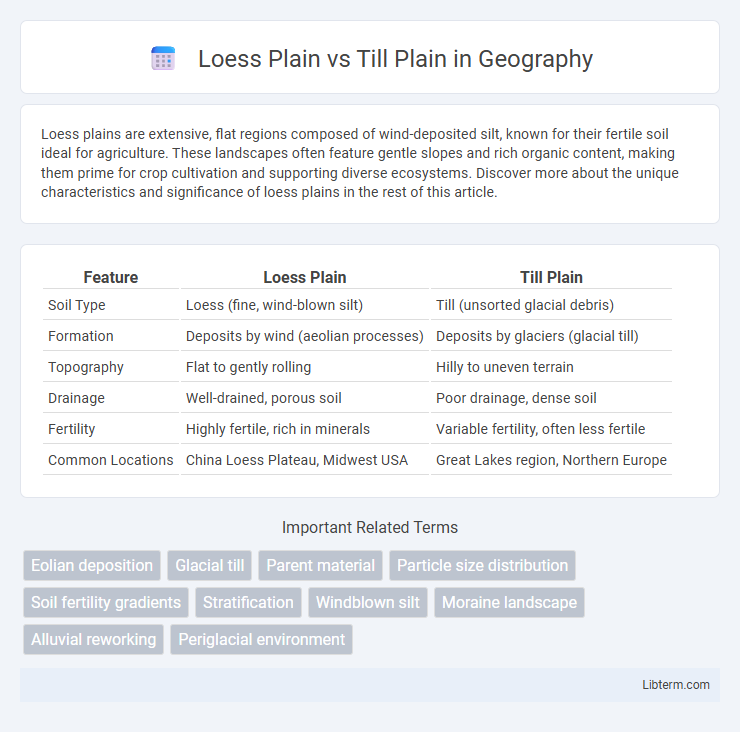Loess plains are extensive, flat regions composed of wind-deposited silt, known for their fertile soil ideal for agriculture. These landscapes often feature gentle slopes and rich organic content, making them prime for crop cultivation and supporting diverse ecosystems. Discover more about the unique characteristics and significance of loess plains in the rest of this article.
Table of Comparison
| Feature | Loess Plain | Till Plain |
|---|---|---|
| Soil Type | Loess (fine, wind-blown silt) | Till (unsorted glacial debris) |
| Formation | Deposits by wind (aeolian processes) | Deposits by glaciers (glacial till) |
| Topography | Flat to gently rolling | Hilly to uneven terrain |
| Drainage | Well-drained, porous soil | Poor drainage, dense soil |
| Fertility | Highly fertile, rich in minerals | Variable fertility, often less fertile |
| Common Locations | China Loess Plateau, Midwest USA | Great Lakes region, Northern Europe |
Introduction to Loess Plain and Till Plain
The Loess Plain is characterized by its fertile, fine-grained silt deposits formed from wind-blown dust, often supporting rich agricultural activities due to excellent moisture retention and nutrient content. In contrast, the Till Plain consists of glacially deposited, unsorted sediments including clay, sand, gravel, and boulders, resulting in a more heterogeneous soil structure with variable drainage properties. Both landforms influence regional vegetation patterns and land use, with the Loess Plain commonly found in areas affected by past loess deposition and the Till Plain prevailing in regions shaped by glacial processes.
Geological Formation Processes
Loess plains form through the accumulation of fine, wind-blown silt particles during glacial and interglacial periods, creating fertile, easily erodible soils. Till plains result from the deposition of unsorted glacial till directly by advancing and retreating ice sheets, leading to a heterogeneous mixture of clay, sand, gravel, and boulders. The primary geological formation distinction lies in aeolian processes for loess plains versus glacial deposition mechanisms for till plains.
Soil Composition and Characteristics
Loess Plains consist primarily of fine, silt-sized particles deposited by wind, resulting in highly fertile, well-drained soils with excellent moisture retention, ideal for agriculture. Till Plains are composed of unsorted glacial till, including a mix of clay, sand, gravel, and boulders, leading to soils with variable drainage and fertility but often heavier texture and lower permeability. The distinction in soil composition between the two plains significantly influences land use, crop suitability, and erosion susceptibility.
Physical Appearance and Landscape Features
Loess plains exhibit fine, wind-blown silt deposits resulting in smooth, gently rolling landscapes with fertile soils ideal for agriculture. Till plains, formed from glacial till deposits, present a more irregular, hummocky terrain characterized by unsorted sediment including clay, sand, gravel, and boulders. While loess plains often feature uniform, flat expanses, till plains display diverse elevations and rocky outcrops shaped by glacial movement.
Fertility and Agricultural Potential
Loess plains exhibit high fertility due to their fine, mineral-rich silt composition that retains moisture and nutrients, making them ideal for intensive agriculture and crop production. In contrast, till plains consist of heterogeneous glacial deposits with variable texture and nutrient content, often resulting in lower fertility and requiring additional soil management for optimal agricultural use. The consistent structure and nutrient availability in loess plains support sustainable farming practices, whereas till plains demand careful soil amendment to achieve comparable agricultural potential.
Distribution and Global Locations
The Loess Plain, characterized by wind-deposited silt particles, primarily extends across regions like the Midwest United States, northern China, and parts of Europe including the Danube Basin, thriving in areas with stable climatic conditions that favor fine sediment accumulation. The Till Plain consists mainly of unsorted glacial deposits or till and is widely distributed in previously glaciated zones such as Canada's Great Lakes region, northern Europe including Scandinavia, and the northern United States, reflecting past glacial movements. Both landforms serve as critical indicators in paleoclimatology and soil studies, with distribution patterns influenced by historical glacial advances and prevailing wind systems.
Drainage and Water Retention
Loess Plains exhibit fine, silt-sized particles that promote high water retention but often result in poor natural drainage, leading to seasonal waterlogging. In contrast, Till Plains consist of mixed particle sizes, offering better drainage due to coarser materials while retaining moderate moisture. The differing textures between Loess and Till Plains significantly influence hydrological behavior and soil water availability for agriculture.
Ecological Significance
Loess plains, characterized by fine, wind-deposited silt, support highly fertile soils that promote diverse agricultural ecosystems and native grassland habitats. Till plains, formed from glacially deposited unsorted sediments, offer varied soil textures that sustain mixed forests and wetland ecosystems, contributing to biodiversity and water filtration. Both landforms play critical roles in regional ecological stability by influencing vegetation patterns, soil health, and hydrological processes.
Human Impacts and Land Use
Loess plains typically feature fertile, fine-grained soils that support intensive agriculture, facilitating extensive cultivation of crops like wheat and corn, while human impacts include soil erosion and nutrient depletion due to continuous farming. Till plains, composed of glacially deposited unsorted sediments, often exhibit mixed soil textures suitable for both agriculture and pasture, but land use also involves urban development and resource extraction, leading to habitat fragmentation and altered drainage patterns. Both landforms require sustainable management practices to balance agricultural productivity with conservation efforts and mitigate adverse human impacts on soil health and biodiversity.
Key Differences Between Loess and Till Plains
Loess plains are formed from wind-blown silt deposits, resulting in fertile, well-drained soils ideal for agriculture, whereas till plains consist of unsorted glacial debris like clay, sand, and rocks, leading to varied soil texture and drainage. Loess plains typically have uniform topography with gentle slopes, while till plains exhibit irregular terrain due to diverse glacial till deposits. The organic content in loess soils is higher compared to till soils, influencing different vegetation patterns and land use suitability.
Loess Plain Infographic

 libterm.com
libterm.com